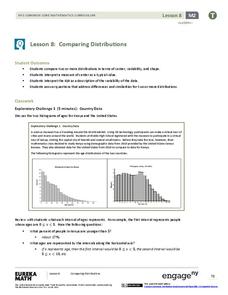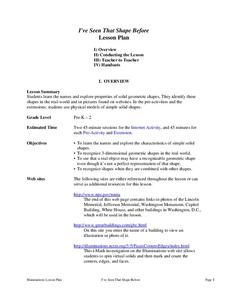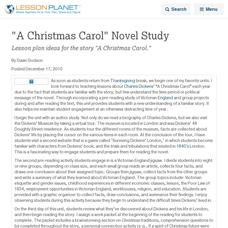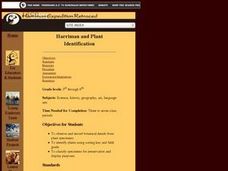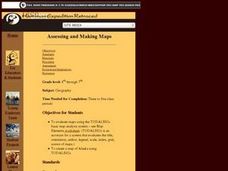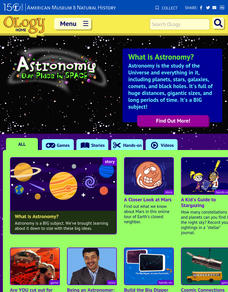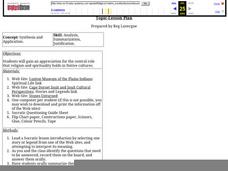Alabama Learning Exchange
Is it a Moth or a Butterfly?
Second graders examine the similarities and differences between moths and butterflies. They participate in a virtual field trip using a designated web site. They design a computer based slideshow using the information they find on the...
EngageNY
Comparing Distributions
Data distributions can be compared in terms of center, variability, and shape. Two exploratory challenges present data in two different displays to compare. The displays of histograms and box plots require different comparisons based...
Fayetteville Public Schools
I've Seen That Shape Before
The objectives in the resource allow students to explore the characteristics of simple solid shapes. Youngsters learn to recognize the face shapes, corners, and edges that make up 3-D figures by filling in a chart. Lastly,...
Curated OER
The American Revolution and Williamsburg
Williamsburg provides a way for students to learn about the American Revolution.
Curated OER
Signs of the Times
Students pretend to be 18th century shopkeepers or trades people and create signs representing their shops or trades.
Curated OER
Harriman and Plant Identification
Students observe and record botanical details from the plant specimens. They identify plants using sorting key and field guide and classify specimens for preservation and display purposes.
Curated OER
Can We Be Both Conservationists and Consumers?
Students explore their role as consumers and conservationists and what roles they play in today's economic climate. They explore resource allocation issues. Students analyze data and draw comparisons between historical and present-day...
Curated OER
How Has Transportation Changed Since the 1899 Harriman Alaska Expedition?
Students recognize modes of transportation. They research historical data from a variety of primary and secondary sources including the Harriman expedition journals, related web sites, and photographs from the expedition. Students...
Curated OER
What Do We Learn From the Repartiation of Alaska Native Artifacts?
Students observe and evaluate evidence of Alaska Native cultural symbols and artifacts. They research historical data from a variety of primary resources, including the Harriman expedition journals, related web sites, oral accounts,...
Curated OER
Learning About Location: Charting the Path of the George W. Elder
Young scholars acquire a working knowledge of the geographical concepts: absolute location, relative location, longitude and latitude. They analyze primary sources that shows the physical and human characteristics of the places along...
Curated OER
A Neighborhood Expedition
Students plan and conduct an expedition through their neighborhood based on the techniques used by the Harriman Expedition to Alaska in 1899. They research the Harriman expedition on the internet and then create a route and collection...
Curated OER
Assessing and Making Maps
Students evaluate maps using the TODALSIGs basic map analysis system, explained on the worksheet. They create a map of Alaska using TODALSIGs. Students brainstorm the elements of maps.
American Museum of Natural History
Planetary Mysteries
A website all about planetary mysteries—it's a one-stop-shop for all things, stars, planets, and space travel. Scholars read an astronomy overview to discover the page's big ideas, then choose from the plethora of resources, including...
Curated OER
Transportation
Students explore basic transportation vehicles, specifically air, land, and water vehicles, name six different modes of transportation, identify four different kinds of train cars, and three differences between two different modes of...
Curated OER
Religion and Spirituality in Native Cultures
Fifth graders gain an appreciation for the central role that religion and spirituality holds in Native cultures. After researching Totems, 5th graders create their own Totems out of construction paper based on their lives and beliefs.
Curated OER
Powerful Poetry Presenting the Writer's Soul
Young scholars research Langston Hughes poetry for his use of figurative language. In this poetry analysis activity, students research the life and poetry of Langston Hughes and his use of vivid words. Young scholars complete...
Curated OER
A Fiedl Study of an Integral Species
Students compile baseline population information on a local species. They design and conduct a scientific investigation of a local species. Students interpret, analyze and communicate results based on sound scientific and mathematical...
Curated OER
Key Figures of the 1899 Harriman Alaska Expedition
Students gain general knowledge of the goals, route, participants, and significance of the 1899 Harriman Expedition. They link names of glaciers, fiords, mountains, flora and fauna with names of the 1899 Harriman Expedition...
Curated OER
Top Budget-Friendly Ways to Include Interactive Technology in the Classroom
Inspire student achievement and participation with multimedia activities.
Curated OER
THE ORPHAN OF ELLIS ISLAND: A TIME TRAVEL ADVENTURE
Fourth graders read the book together and imagine what it was like to come through Ellis Island as an immigrant to the United States. They write a story describing the process at Ellis Island from a first person perspective. They share...
Curated OER
Starry Night
Learners examine Van Gogh's work Starry Night. Foreground and background are discussed. Students create their own version of Starry Night using crayons and black paint. Learners create their very own crayon relief.
Curated OER
Celebrating our Heritage Buildings
Ninth graders create a scavenger hunt with clues related to a building they have researched. Working in small groups, they use the internet and traditional resources to find information pertaining to a historical building. Students use...
Other
National Music Museum: Virtual Tours
Enjoy browsing through this virtual music museum. You will see many different pictures ranging from instruments of the Civil War to former President Bill Clinton's saxophone.

